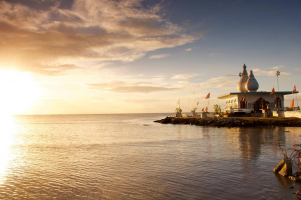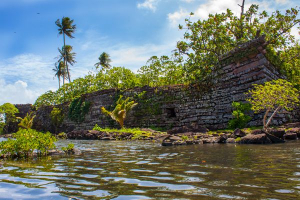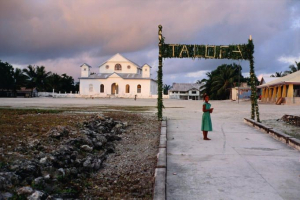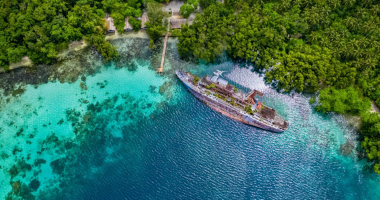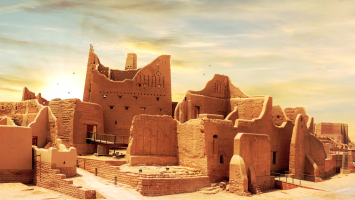Top 10 Most Beautiful Historical Sites in Tanzania
Tanzania, in East Africa, is a country with a lot to offer in terms of magnificent wildlife, savannas, and beaches, as well as historical sites worth seeing. ... read more...The island paradises of Zanzibar and Mafia Island are easily accessible from Tanzania's mainland, particularly Dar es Salaam, the country's largest metropolis and the world's largest Swahili-speaking city. Although many people visit this part of the world for the islands and beaches, there are still many cultural and historical monuments to explore. Here are ten most beautiful historical sites in Tanzania that you should visit on your next vacation to this inspirational part of the world. Africa should be aware of the objective.
-
The first beautiful historical site is Stone Town. The old urban fabric and environment of the city complex have been preserved to a significant extent. The architecture, its use, and the street layout continue to reflect the flow of human ideals across the Indian Ocean. The city's construction materials and techniques are still widely employed in the Zanzibar archipelago and the Swahili coastal region.
Stone Town was designated a UNESCO World Heritage Site in 2000 for its historical significance and 19th-century stone architecture, and it is now one of Tanzania's most prominent historical and tourism attractions. Stone Town is home to a plethora of attractions, including museums, monuments, and historic landmarks influenced by Arabia, Persia, India, and Europe. The months of June through October are thought to be ideal for visiting.
Location: Zanzibar City, Tanzania

Photo: https://bornparkadventures.com/ 
Photo: https://commons.wikimedia.org/ -
Learn about Tanzania's past and cultural mosaic at the History Room and Ethnographic Collection, which includes the Shirazi culture of Kilwa, the Zanzibar slave trade, and German and British colonial times. Despite the upgrades, the museum still needs to work on creating appropriate displays and constructing a cohesive narrative.
The National Museum, which opened in 1940 and has since played an essential role in exhibiting Dar es Salaam, Tanzania's culture, and legacy to visitors, is a must-see. In-depth fossils dating back to human origins in the Olduvai Gorge are on display at the museum. Guests will have the opportunity to learn about Tanzanian tribal customs. View traditional crafts, rituals, jewelry, and musical instruments while learning about the country's slave trade's colonial history.
Location: Dar es Salaam, Tanzania

Photo: https://www.lonelyplanet.com/ 
Photo: https://www.tripboba.com/ -
The town museum provides a fair overview of the different types of architecture prevalent in the area. This open-air museum features a collection of 19 realistically reproduced residential buildings that depict Tanzania ethnic groups' traditional ways of life.
The Village Museum's mission is to educate Tanzanians and the rest of the world about the various ethnic groups that make up the country's diversity. This is represented by a display of 16 Tanzania ethnic cottages. Daily shows with traditional music and dance, as well as a souvenir shop with traditional Tanzanian décor and a selection of traditional delicacies, are among the other attractions.
Location: Dar es Salaam, Tanzania

Photo: https://izi.travel/ 
Photo: https://africantourer.com/ -
Askari Monument is one of the most beautiful historical sites in Tanzania. This monument is notable because it commemorates the Askari troops who perished while serving in the British Corps during WWI. It is situated near the crossroads of Samora Avenue and Maktaba Street, in a busy and energetic area of the city. The monument was first opened to the public in 1927, adding to the city's historical significance.
The monument's centerpiece is "The Askari," a bronze soldier statue. James Alexander Stevenson, a British sculptor who worked for the Morris Bronze Founders of Westminster, created it. The statue was signed by Stevenson under the pseudonym "Myranda." Another statue stood near the Askari memorial, that of Hermann von Wissmann, a German explorer and army officer who served as administrator of German East Africa in the late 1800s.
Location: Dar es Salaam, Tanzania

Photo: https://cityseeker.com/ 
Photo: http://www.amariah.co.tz/ -
This magnificent institution's purpose is to be Dar es Salaam's foremost multi-art center and creative hub, honoring the arts in all of their forms. This is undoubtedly a venue for individuals who wish to understand a little more about Tanzania's creative culture, including concerts, art studios, and other programs and structures to assist and develop new artists. They are also proud of the economic side of the visual arts, which they promote through training and exchange programs.
In Tanzania's Mikocheni Light Industrial Zone, the Nafasi Art Space serves as a shelter and gallery for Tanzanian visual artists and designers. It is maintained by a non-governmental organization and provides a location for artists to work, learn, meet people, and display their talent, with the word "Nafasi" meaning "space" in Swahili.
Location: Dar es Salaam, Tanzania

Photo: https://www.nafasiartspace.org/ 
Photo: https://www.nafasiartspace.org/ -
This significant archaeological site has unearthed ancient bone and skull fragments that have revealed valuable information about early humankind. In the natural reserve, the Olduvai Gorge is also worth seeing. This significant archaeological site has unearthed an ancient skull and bone fragments that have revealed critical details about the origins of humanity.
In northern Tanzania, the Olduvai Gorge (also known as Oldupai) is a rich paleoanthropological site to visit during a safari and cultural holiday in East Africa. The canyon is a deep ravine more than 48 kilometers (30 miles) long with a weathered monolith on which the layers of subsequent climatic variations may be observed for millions of years. It is located between the Ngorongoro Maasai Land and the Serengeti Wildlife Plains.
Location: Zanzibar, Tanzania
Photo: https://g-switch.org/ 
Photo: https://artofsafari.travel/ -
Kilwa Kisiwani was occupied from the 9th to the 19th centuries, with the 13th and 14th centuries being the most prosperous. Ibn Battouta, a notable traveler, stopped here in 1331-1332 and rated Kilwa as one of the most beautiful historical sites in the world.
Kilwa is a full-length film. Kilwa Kisiwani was a historic Islamic city-state located off the coast of what is now southern Tanzania on an island. It became one of the busiest trade towns on Africa's east coast after being founded in the late 10th century by settlers from Arabia and Persia (now Iran). It was briefly held by the Portuguese (1505-112) before progressively fading in importance and being abandoned. Mosques, a Portuguese castle, and the magnificent Husuni Kubwa Palace have all been maintained (13th-14th centuries).
Location: Kilwa District, Lindi Region, Tanzania

Photo: https://twitter.com/ 
Photo: https://ngaaliinflightmag.com/ -
The original boundaries of Kilimanjaro National Park, established in 1973, included the entire mountain above the tree line as well as six forest corridors that ran down through the montane forest zone. The main pressures at the time of inscription in 1987 affected mostly the forest reserve, which served as a buffer zone for the park. The World Heritage Committee proposed that the national park be expanded to incorporate more montane forest areas. The National Park now encompasses the entire mountain above the tree line, as well as the natural forest (montane forest) that was previously part of the Kilimanjaro Forest Reserve, and so meets the criterion for integrity. The National Park's expansion must be reflected in the property's limits.
Although the property is not inscribed concerning biodiversity standards, the wildlife on the resort is vital to the Kilimanjaro experience. At the time of inscription, elephant, buffalo, and antelope pressures, as well as logging in the Forest Reserve region, were identified as integrity problems. The park is connected to Amboseli National Park, although wildlife migration has been hampered by encroachment on corridors to Arusha National Park and Tsavo National Park.
Location: Kilimanjaro Region, Tanzania

Photo: https://whc.unesco.org/ 
Photo: https://www.kenyawildlifetours.com/ -
Natural rock shelters, overhanging slabs of sedimentary rocks broken by rift faults, have been employed for rock painting for at least two millennia on the eastern slopes of the Masai escarpment bordering the Great Rift Valley.
The actual number of rock art sites in the Kondoa area is unknown, although between 150 and 450 decorated rock shelters, caves, and overhanging cliff walls are thought to exist. The locations are on the steep eastern slopes, in an area of beautiful, shattered geological formations that offered the needed cover for the exhibition.
Over millennia, the enormous and rich collection of rock drawings has represented and embodied the cultures of both hunter-gatherer and pastoralist tribes who have lived in the area. They are distinct examples of hunter-gatherer rock art at its northernmost extent, with similarities to images from southern and central Africa, as well as a peculiar streaky style and uncommon depictions of domesticated animals.
Location: Kolo, Tanzania

Photo: https://whc.unesco.org/ 
Photo: https://www.wildsecretsafaris.com/ -
The last beautiful historical site in this list is Serengeti National Park. The annual migration of two million wildebeests plus hundreds of thousands of gazelles and zebras – followed by their predators in their annual migration in search of pasture and water – in the vast plains of Serengeti National Park, which covers 1.5 million hectares of savannah, is one of the most impressive natural spectacles in the world. The park has a high level of biological variety, with at least four globally threatened or endangered animal species present: black rhinoceros, elephant, wild dog, and cheetah.
The Serengeti plains are home to the world's greatest unmodified animal migration, with over one million wildebeest and hundreds of thousands of other ungulates taking part in a 1,000-kilometer annual cyclical trip across Kenya and Tanzania. This remarkable phenomenon occurs in a one-of-a-kind beautiful setting known as the "endless plains": 25,000km2 of treeless expanses of breathtakingly flat short grasslands punctuated with rocky outcrops (kopjes) and rivers interspersed with woodlands and rivers. The Park also features one of the world's largest and most diverse huge predator-prey interactions, delivering a visually stunning experience.
Location: northern Tanzania
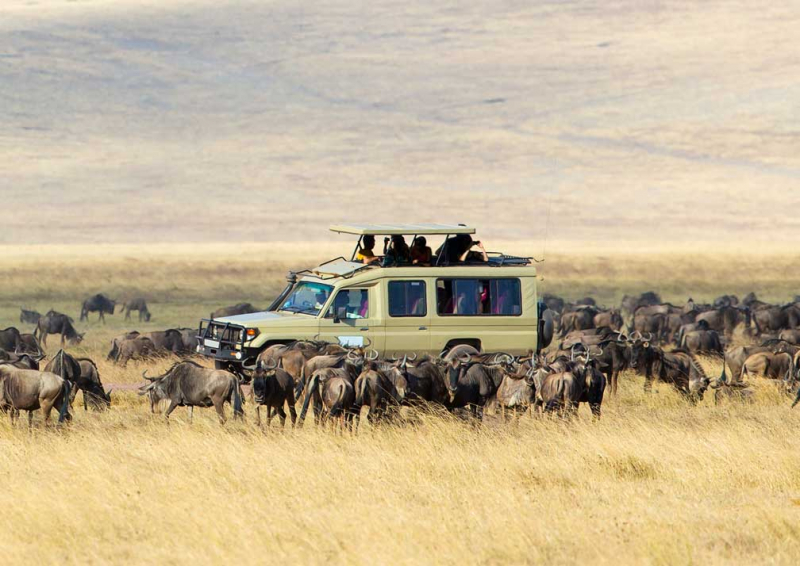
Photo: https://www.kenyawildlifetours.com/ 
Photo: https://www.viator.com/













